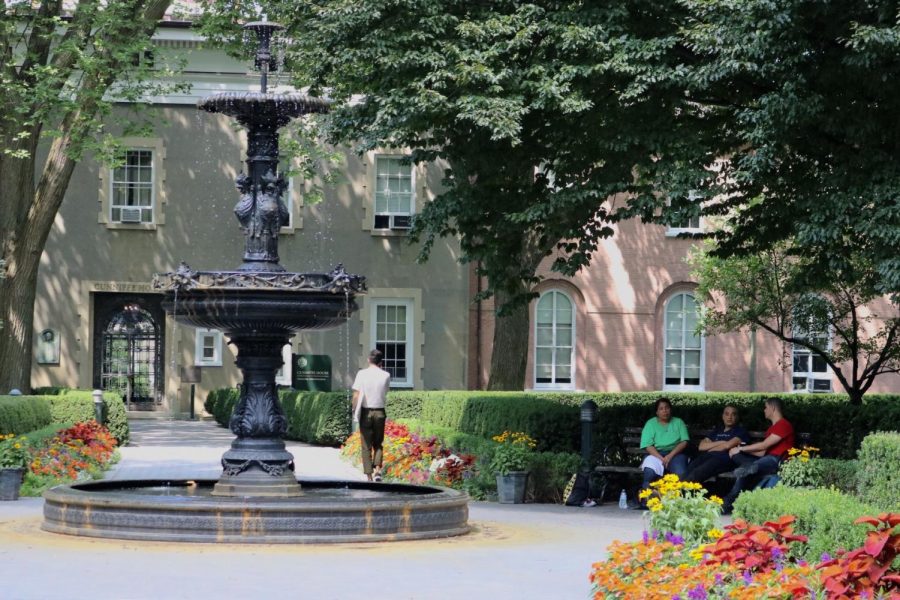University Releases ‘Climate Action Plan: 2018 Annual Executive Update’
By Helen Stevenson
The university’s office of the vice president for facilities management and sustainability released the Climate Action Plan: 2018 Annual Executive Update. The 18-page report reestablishes the university’s current commitment to sustainability and reaffirms its goal of achieving 40 percent emissions reduction by 2030.
In 2007, Fordham University joined the New York City Carbon Challenge in 2007 and committed to reducing its greenhouse emissions by 30 percent by 2017. Although the university did not meet their goal, it reduced emissions by 24.6 percent and has every intention of reaching their 40 percent goal by 2030.
“Fordham will continue to evaluate its current list of potential projects and to identify new projects in order to achieve this goal by 2030,” the report reads. “Fordham’s decisions regarding which projects to implement will be based on our capital budget an the payback of project investments”
Gabby Perez, FCRH ’21 and co-chair of sustainability committee said that the 40 percent goal is encouraging, but the university could do more to reduce its carbon footprint.
“While I applaud the university for being on track to meet the 40 percent carbon emission reduction goal by 2030, meeting this goal is the bare minimum,” she said. “I am even wondering why the university does not strive for the 50 percent by 2025 goal.”
Lauren Beglin, FCRH ’19 and Perez’s co-chair of sustainability committee, agrees with her sentiments. However, she said that although she thinks meeting energy reduction goals is critical, she thinks the transition to 100 percent renewable energy is just as if not more important.
“I was surprised that no mention was made of converting Fordham to 100 percent renewable energy by 2040 given Governor Cuomo’s pledge to transition the state as such, and think that the University needs to consider ways they can achieve this goal and begin their implementation,” she said.
In order to reduce energy usage in a cost-effective manner moving forward, the university will pursue “alternative energy strategies” using new technology.
“The University completed two strategic LED relamping initiatives on both the Rose Hill and Lincoln Center Campuses in 2015 which will help the University conserve annually 712,000 kWh of energy,” the report states.
The initiatives are underway in 11 buildings on the Rose Hill (RH) campus and will continue to be adjusted.
Auniform recycling program was installed at Lincoln Center (LC) and RH to manage waste, recycling and minimization.
“Ongoing educational efforts involving students, faculty and staff as well as more and revised placement of recycling bins throughout all campus buildings, both residential and academic have improved this initiative,” reads the report.
All new buildings on campus will be designed to ensure environmental responsibility, as established in this report. In addition, the university dedicated Campbell, Salice and Conley Hall the first green building built on campus and was awarded LEED Gold Certification.
The university’s Department of University Transportation also converted its 38 “Ram Vans” to biodiesel-capable vehicles in order to reduce annual CO2 emissions by 31 percent.
The report emphasizes the importance of meaningful curriculum and academic programs. The Gabelli School of Business offers four-day intensive master class that focuses on sustainable business ventures and the environmental studies department has been offered at the university since 2002.
Beglin said that the educational initiatives are among the biggest improvements in the 2018 plan.
“The University has definitely made tangible process toward making sustainable knowledge more accessible through [education]…but I think expanding the reach of this information is very much possible and necessary,” she said.
Beyond the plans outlined in the report, Perez said that there is much more Fordham could do to be a leader in sustainability.
“For example, the university could look into joining the 21 other New York colleges and universities in a renewable energy purchasing consortium, or install more solar panels on or off campus at the site in Staten Island, or look into divesting from fossil fuels,” she said.
Perez said that knowledge of climate change has increased since 2008 when these goals were initially made.
“I urge Fordham to push their goals further and become a real sustainability leader for other school’s in New York and other Jesuit universities across the nation,” she said.







































































































































































































